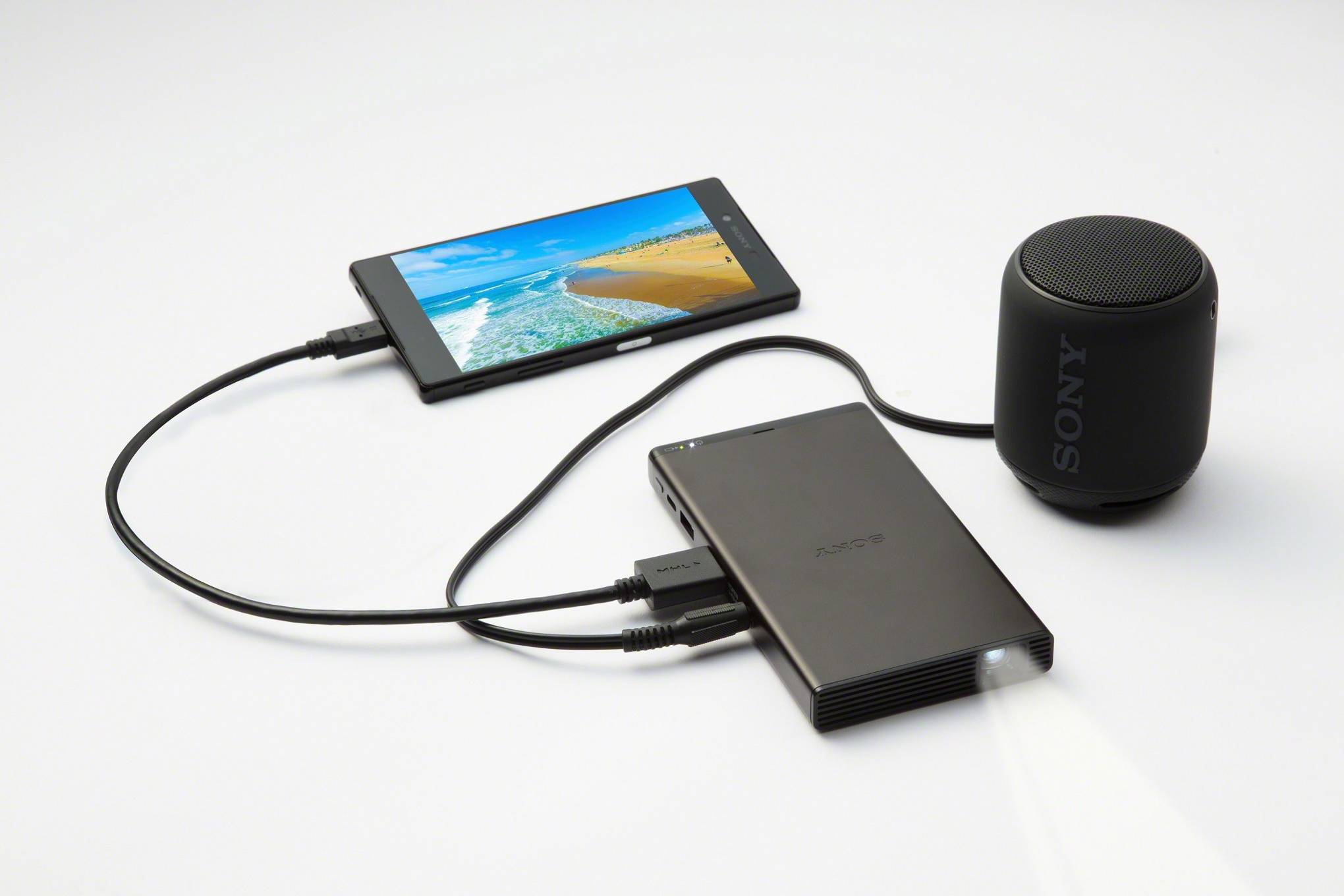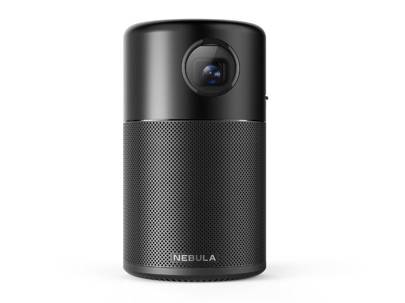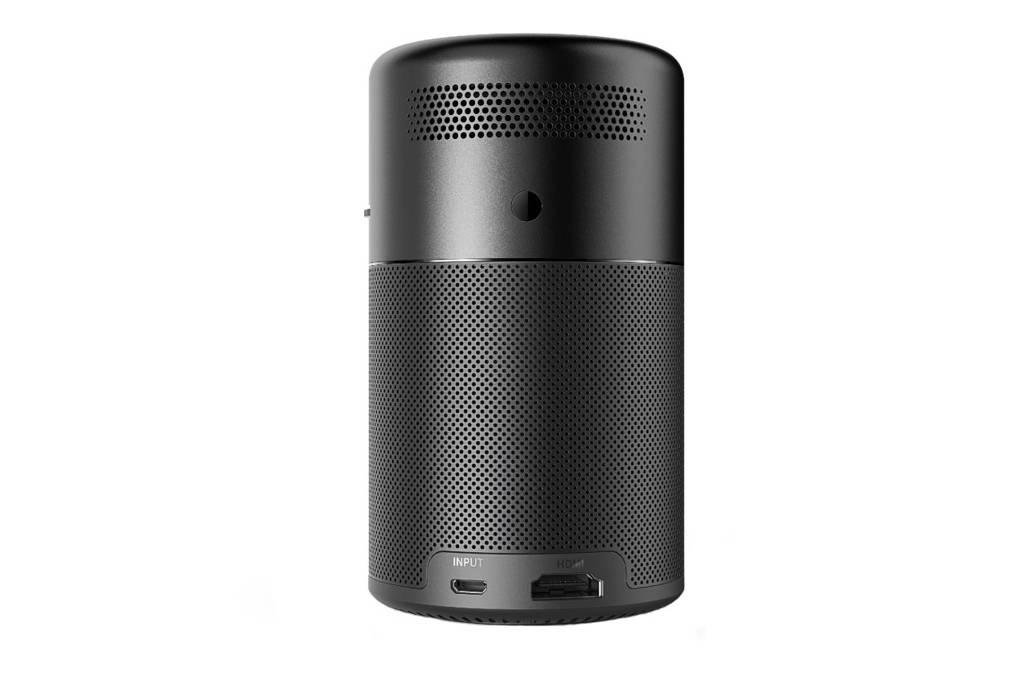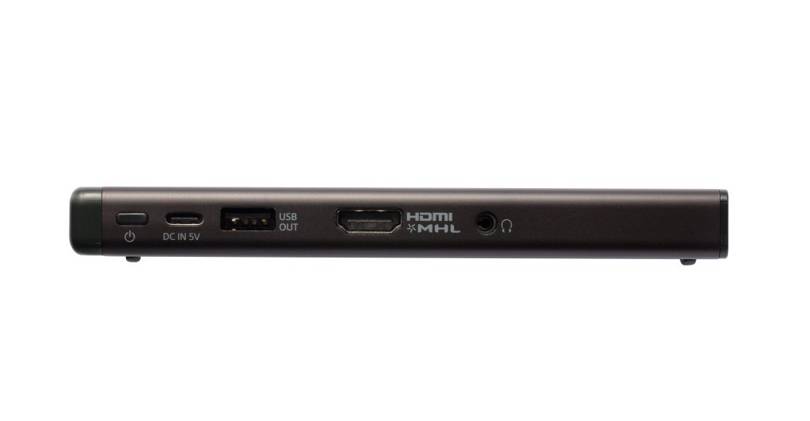
Projectors

The Sony MP-CD1
For transport and set-up, the Sony is superior. The flat rectangular frame is much more bag-friendly than the ‘soda can’ design of the Nebula, which is also 140g heavier, likely due to the larger speaker. Sony’s projector also comes with an HDMI cable in the box, which is a nice touch. The Nebula is compatible with HDMI also, but accepts USB input too, as well as the very handy wireless 'screencasting' function from smartphones, tablets and certain laptops over WiFi.
When turning them on, the Sony is much faster, the five second quick boot it boasts on the box being fairly accurate. As the Nebula has an Android 7.1 operating system built in to keep all its numerous features together, it takes a good 20 seconds to get to the menu, and then a few button presses to actually get the display going. It's not hard to navigate, the layout is simple to move around with the included remote control, and all the functions are clearly labeled, but it's not as simple as the Sony's menuless design that just displays whatever you plug into it as soon as it's warmed up.
Check This: JBL Boombox Review: Blows your mind away
Picture
In terms of picture (tested using catch-up TV documentaries and YouTube gaming footage), the pair work equally well in complete darkness, and fare OK in well-lit rooms. The Sony has a brightness of 105 lumens, while the Nebula has one of 100, and it’s a difference too small to notice. While more inconvenient to carry about, the extra height of the Nebula’s lens means you can project with greater flexibility, especially with its automatic and manual keystoning letting you find the best angles.
 The Nebula Capsule is an all-in-one projector and speaker the size of a coke can, and it even has on-board WiFi for Netflix streaming
The Nebula Capsule is an all-in-one projector and speaker the size of a coke can, and it even has on-board WiFi for Netflix streamingKEYSTONING AND KEYSTONE CORRECTION
WHAT IS IT?
'Keystoning' is what happens when you project a rectangular or square image onto a surface at a, and it instead turns into a trapezoid shape, the same as keystones which are placed in the top of an arch in building.
HOW CAN IT BE FIXED?
Through the use of specially designed software, the original image can be distorted before it is projected, therefore making the image its normal shape when seen on the surface.
ARE THERE ANY PROBLEMS WITH KEYSTONE CORRECTION?
The processing involved means that the resolution of the image can be reduced, meaning that it is always best to project at a flat angle without any correction when possible.

The Sony also has automatic keystoning, but projects from only a centimetre off the surface it is sitting on, meaning you need a much clearer area, and likely the edge of a table or something similar, to get an uninterrupted image. While likely not a major issue for users, both projectors have a tripod socket on their undersides, allowing a greater range of angles and better stability if required.

Sound
Listening to the two is where the Nebula starts to show why it is weighs and costs more. The Sony’s inbuilt 1W speaker is obviously weak, and akin to listening to sound from your phone’s loudspeaker, which seems oddly poor quality in comparison to the picture quality. It is thoroughly thrashed by the Nebula’s 5W 360° speaker, which is comparable to a similar sized wireless mini-speaker, and therefore a lot more enjoyable to listen to. Fortunately, the Sony has a 3.5mm audio jack, letting you connect it to a better set of speakers, or headphones if you need it for personal use. If what you want to show on your projector has sound as an important component, and you don’t have access to a separate sound system, this is where the Nebula makes sense.

The other noises they make while running come from the cooling fans. The Sony boasts about its quiet running fan, and it is indeed reasonably quiet, a little louder than a laptop (and therefore noticeable), but not distractingly so. The Nebula was louder again, but still not an irritation when watching video on it, and helped by being masked better by the more powerful speaker.
Battery
There is a fairly large disparity in battery life. According to the manufacturers claims, the Nebula has a four-hour battery capacity (thanks to tech borrowed from Anker), while the Sony only has two hours – which would make anything approaching the length of a full-length film a tight fit. During non-stop testing, the Nebula died pretty much on schedule, while the Sony actually lasted for another half an hour. There was, however, some screen tearing as its battery ran down, particularly noticeable when watching video with a lot of movement.
The Nebula’s better when you need to recharge, too. It comes with a mains adaptor to put on the end of its included USB cable, while you can’t charge the Sony projector from a normal mains socket. Despite the difference in capacity, the two both reach full battery at the two-and-a-half hour mark. The Capsule also has a rapid charging function, which lets it reach 70 per cent in just an hour.

The Capsule has many additional functions that the MP-CD1 does not feature. It uses a remote, either the physical one included with the projector, or the App-based version for smartphones, to navigate between the different inputs and its own 8GB storage in the Android OS. As previously mentioned, it can hook up to a WiFi connection to project internet streaming services like YouTube and Netflix, or to screencast mobile devices (this is possible on the Sony too if you buy the separate HDMI dongle). You can even turn the projection part off completely, leaving you with a speaker with 30 hours of battery life.
This WiFi functionality certainly makes the Capsule a little less straightforward to use as a simple projector, but it may well be useful for people who don’t intend to move it around much, and would serve well as a mobile home projector for indoors and outdoors, or for dedicated travellers with space in their bags to spare.
Conclusion
Sony and Nebula have taken disparate paths when designing their products. This is obvious enough from the product descriptions: the MP-CD1 is a "mobile projector", while the Capsule is a “pocket cinema”. One is designed to cover the basics, the other to be a fully rounded device capable of doing more than just project.
For basic and convenient functionality (and a healthy amount of money saved), the Sony is best. In terms of diversity of uses and quality of viewing and listening experience, the Nebula triumphs. Your choice will ultimately be dependent on what you want from a pico-projector: super slim or mini cine.
SPECS - SONY MP-CD1 & NEBULA CAPSULE
DIMENSIONS
Sony - 83mm x 16mm x 150mm
Nebula - 68mm x 68mm x 120mm
WEIGHT
Sony - 280g
Nebula - 420g
ESTIMATED BATTERY LIFE
Sony - 2 hrs
Nebula - 4 hrs
MAXIMUM PROJECTION SIZE
Sony - 120 inches (at 3.45m distance)
Nebula - 100 inches (at 3.08m distance)
OUTPUT RESOLUTION
Sony - 854 x 480
Nebula - 854 x 480
BRIGHTNESS
Sony - 105 lumens
Nebula - 100 lumens
CONNECTIONS
Sony - HDMI in, 3.5mm phone jack out (wireless HDMI "Miracast" dongle sold separately)
Nebula - HDMI in, USB in, WiFi, Internal 8GB storage

Post a Comment